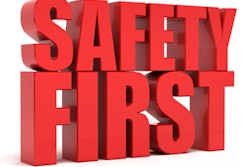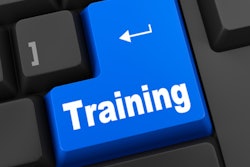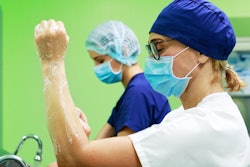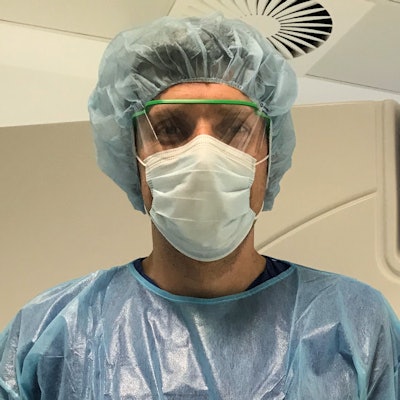
Radiographers have found themselves on the front lines during the COVID-19 pandemic, and there's a growing awareness that radiology departments must develop and implement a strategy to keep radiographers and patients safe. But how can this be done?
We asked five experienced European radiographers about their work and how they minimize transmission of the virus. What personal protective equipment (PPE) do they use? How do they disinfect the CT scanner between patients? And which guidelines do they follow in this area?
David Guenther, radiographer, Charité - Universitätsmedizin Berlin
We wear our PPE for only one patient; after every patient, we dispose of it. The PPE consists of cover for the hair, goggles or a face shield, simple mouth and nose protection, a virus-proof protective apron, and gloves. We don't use protection for our shoes.
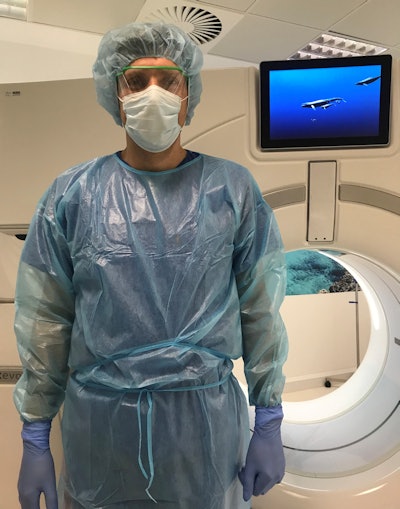 David Guenther.
David Guenther.We've established a separate CT machine for patients with COVID-19 or with suspected COVID-19. The room is nearly empty and only contains necessary equipment. During an average day, we examine between three and 10 patients.
After an examination, the radiographer disinfects the CT and all surfaces that may be contaminated, and then a cleaner cleans the whole floor in the room. The disinfectant has to dry for 15 minutes. All in all, the disinfection procedure after a COVID-19 patient takes at least 30 minutes. We ask staff from the hospital ward to wait in the corridor during the examination.
The important thing is to allow enough time between patients for disinfection. It is a lot of extra work for our radiographers right now, and it has implications in terms of patient throughput and patients, but during the past few weeks we've seen that our measures are working, and that's very encouraging for everybody.
We use the following internal document: CT-Abteilung CVK: Handlungsanweisung zum Umgang mit SARS-CoV-2-infizierten Patienten und Verdachtsfällen, created on 30 March 2020.
Nick Woznitza, PhD, clinical academic reporting radiographer, Homerton University Hospital, London, and Canterbury Christ Church University, Canterbury, U.K.
On PPE, we follow the recommendations of Public Health England. On 9 April 2020, the U.K. Society of Radiographers interpreted these guidelines for imaging departments to presume that all imaging requires radiographers to wear gloves, apron, fluid-resistant surgical mask (or FFP3 in intensive care unit), and eye protection.
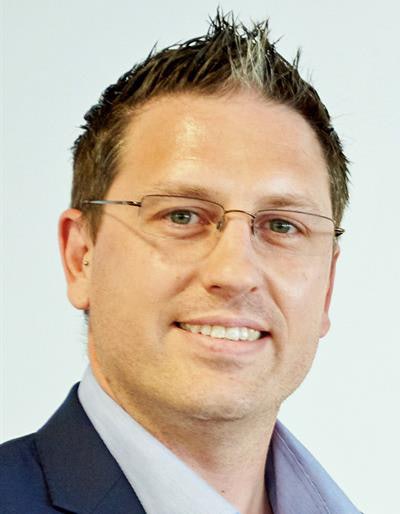 Nick Woznitza, PhD.
Nick Woznitza, PhD.It's important to remember the role of CT is not as a screening tool or for primary diagnosis. Where possible, departments are trying to stream into "hot" and "cold" scanners. In my experience, this may not be feasible or may not be practical, as many patients are asymptomatic and the volume of nonurgent work has decreased significantly.
As for cleaning procedures, including adequate air exchange to limit transmission, there was a very good July/August 2015 paper published in RadioGraphics: "Microbiology for Radiologists: How to Minimize Infection Transmission in the Radiology Department." Sufficient time needs to be given after the scan and prior to cleaning of surfaces to allow droplets to "fall" and to reduce transmission risk to staff performing the cleaning of equipment.
We have temporarily altered our radiographer work pattern to reflect demand; outpatient and general practitioner (GP)/primary care imaging has essentially halted, but we have seen increases in the number of mobile imaging (x-ray/ultrasound) exams being performed. At Homerton, we already had rapid reporting -- at the time of exam for the emergency department and same day for primary care. We now immediately report all GP imaging as patients are returning to "hot" and "cold" hubs that may not have access to electronic reports.
Routine imaging is being postponed and patients are not attending, even for urgent appointments, including to the emergency department. We are potentially storing up a tidal wave of delayed diagnosis, e.g., for cancer and heart disease, and we need to encourage patients who are unwell to seek medical attention. It will take time and effort to plan a recovery as we return to nonurgent imaging, and this will need to be managed across regions, not just focused on a single hospital or department.
Our group has published a case series to support radiographer preliminary interpretation of chest imaging and triage for immediate radiologist reporting when suspicious. This article may be of interest to your readers, and it's available for free. My co-authors, Arjun Nair and Sam Hare, are also executive committee members of the British Society of Thoracic Imaging, who have been leading the way during the pandemic.
Kevin Barros Azevedo, PhD, lecturer, medical imaging and radiotherapy department, University of Algarve, Portugal
Our PPE comprises an apron, shoe protection, cap, FFP2 mask, two pairs of gloves, and eye protection. The ideal situation is to change the PPE between patients, but clinical reality requires us to keep the mask, cap, and eye protection after each patient, just changing the gloves and apron.
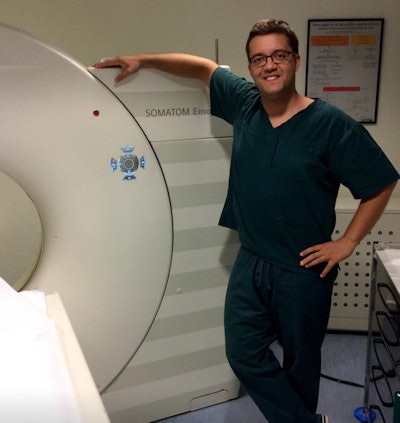 Kevin Barros Azevedo, PhD.
Kevin Barros Azevedo, PhD.The safest way is to deep clean the entire room and the equipment between suspected COVID-19 patients. However, this is not always possible in an everyday CT setting. The important thing is to clean surfaces between the suspected cases and between the confirmed cases and then deep clean between groups of suspected and confirmed cases; the first group must be the suspected cases, and the second group should be the confirmed ones.
To maximize throughput while ensuring safety, we group suspected patients, confirmed patients, and regular patients, since deep disinfection takes a long time. Positive patients must be handled very carefully, and the downtime and deep cleaning is mandatory.
We follow mostly local guidelines and our institution's infection control policies. We also find the Spanish guidelines are interesting too. Issued by the Spanish Society of Medical Radiology (SERAM) on 23 March 2020, they are called "Infección COVID-19. Lo que el técnico debe saber."
Jonathan McNulty, PhD, president, European Federation of Radiographer Societies (EFRS), and associate dean for graduate studies, School of Medicine, University College Dublin
Chest radiography, conventional chest x-ray, and CT have a significant role to play in the management of patients with COVID-19, but a range of approaches are being taken to manage the cleaning of scanners following suspected and confirmed COVID-19 cases. Some sources have indicated huge numbers of patients being scanned on dedicated COVID-19 systems, but one would have to question the level of cleaning that is possible with over 80 suspected or confirmed COVID-19 patients being imaged per day.
 Jonathan McNulty, PhD.
Jonathan McNulty, PhD.Radiographers are front-line healthcare personnel, often in direct contact with suspected or confirmed COVID-19 patients, so radiographers must have access to PPE. We know that PPE can be in short supply in some countries and in some centers, but no healthcare professional should be required or directed to put themselves at unnecessary additional risk on the basis that PPE is not available to them, simply because they are radiographers and not doctors or nurses. Best practice is to use PPE appropriately and when necessary, and to change PPE between cases.
All radiographers and other CT staff must be familiar with the policies and procedures in place and should keep updated on the latest guidance -- national and international -- on how best to balance throughput and infection control issues. I recommend the project initiated by Prof. Peter Hogg from the University of Salford, U.K., and Ken Holmes, University of Cumbria, U.K., who have led an international group of over 40 authors from across the world to create teaching and support materials. Many hospitals and regions are spending time to create teaching and support materials, and the work being done here should save people a lot of time by providing a single international resource. The use of PPE is covered in these resources.
Moreno Zanardo, PhD, department of biomedical sciences for health, Università degli Studi di Milano
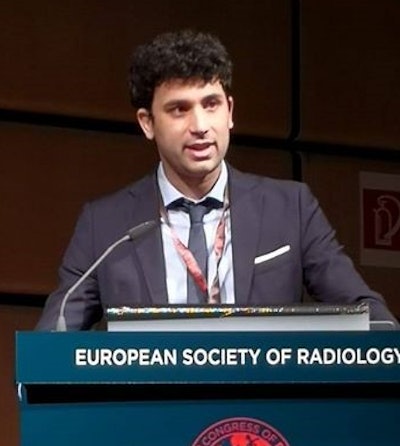 Moreno Zanardo, PhD.
Moreno Zanardo, PhD.We are honored to be involved in an international project with the aim to create a web-based information and support system for radiographers to help them when imaging COVID-19 patients. The International Society of Radiographers and Radiological Technologists (ISRRT), in partnership with the European Federation of Radiographer Societies (EFRS), developed e-learning resources on COVID-19 for radiographers across the world who are caring for our patients as front-line staff. This material is available free of charge.
As Stefano Durante, president of the Italian Federation of Scientific Radiographers Societies (FASTeR), has said, it is so important to thank all radiographers and radiology personnel involved in the war against COVID-19.




